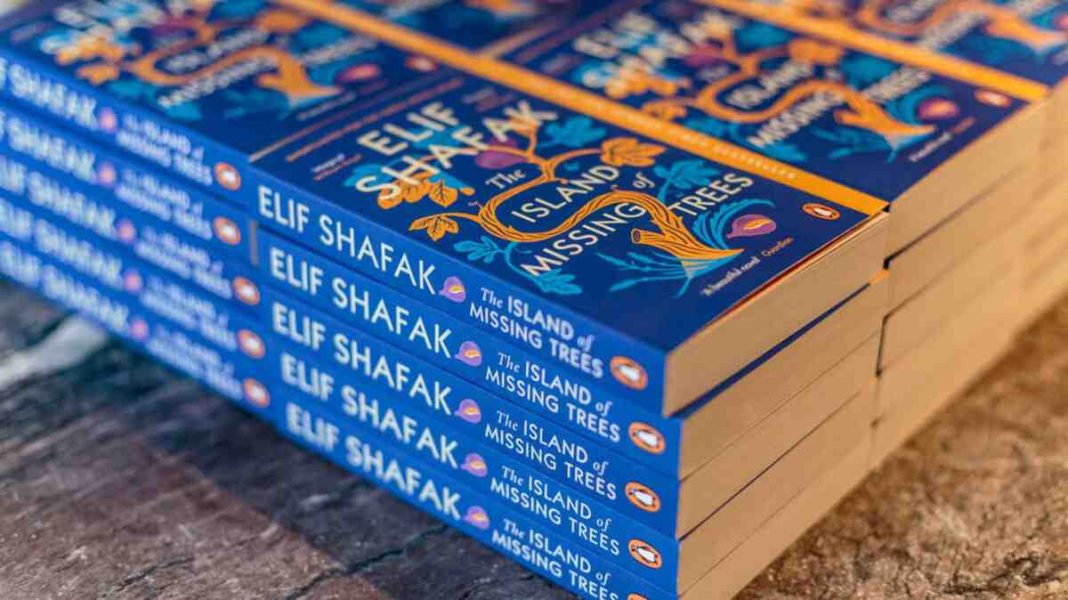A major factor that makes Elif Shafak a popular contemporary author is her effortless style of writing. Within the garb of what could be said to be an easy read, Shafak manages to explore some heavy themes in her writing, ranging from religion, culture, and social prejudices to history, migration, and trauma. Not filled with literary jargon, the novelist’s writing comes across with a certain ease that allows the readers to identify with it. Cosmopolitanism, the convergence of cultures, the conflict between the East and the West, and the native land constitute some of the predominant and also autobiographical elements that are found in the writings of contemporary writers of Turkish origin. Much like the Nobel Laureate Orhan Pamuk, Shafak too can be hailed as a “chronicler” of culture, which is also reflected in her latest work, “The Island of Missing Trees.”
The title “Island of the Missing Trees” itself is suggestive of the presence of the natural world. It is a tale told by a tree—a fig tree or a once “happy fig” tree. The story opens by taking the readers down the memory lane of a Ficus carica. However, before delving into the story of Kostas and Defne, the fig tree states its purpose: it was going to tell the story of losers, the ones history often forgets to mention.
Spoilers Ahead
‘The Island Of Missing Tree’ Book Summary
The narrative deals with three simultaneous timelines: one that takes place in present-day London, another that talks about 1974 Cyprus Island, and a third that is narrated by the fig tree. Defne and Kostas are two young people in love, but what makes their otherwise ordinary love story extraordinary is their cultural difference and the conflict arising out of it. Kostas is a Greek Christian, while Defne is a Turkish Muslim. The romance between the young lovers blooms in a tavern, a place that eventually becomes a site of love and memory as well as trauma and separation. This tavern had been the home of the century-old fig. As the fig stretched its branches and grew happily, it was witness to the forbidden love of Kostas and Defne as well as the love between the two men, Yusef and Yiorgos, who were also the owners of the “Happy Fig” tavern. The happy days in the tavern soon come to an end when the conflict between the Turks and the Greeks reaches its peak, and the island undergoes a civil war. As a result, Yusef and Yiorgos suffer the exposure of their identity as a gay couple, and Kostas is forced by his mother to leave the island and Defne behind and stay with his uncle in England.
Years later, when Kostas returns to the island of Cyprus, he finds his home a changed place. The ravages of the Civil War had left its stain everywhere. Unable to forget Defne even after all these years, Kostas plans to meet her. Defne, on the other hand, blames Kostas for leaving her and betraying their love. Through the detailed account of Defne’s losses (a pregnancy she had to go through alone and the loss of her infant child), the violence she was a witness to, and the tragic fate of the many islanders because of the war, the readers are provided with a real and vivid image of the trauma suffered. Now cold and distant, Defne is an archaeologist who works with the CMP, the Committee on Missing Persons. In a very subtle manner here, Shafak manages to bring to light one of the most gruesome outcomes of conflict—the case of missing persons. Using the characters as her spokesperson, Shafak emphasizes the otherwise ignored subject, shifting the attention from the cataclysmic consequences faced by the nation to the personal and the natural. This is further elucidated in her characterization of the fig tree.
Perhaps the most fascinating and intriguing aspect of the novel is Elif Shafak’s treatment of the natural, which is infused with the magical. The story is replete with symbolic representations; needless to say, ‘tree’ is the primary symbol. Divided into six parts, each part of the novel is designated a title with reference to the tree: The first being “How to Bury a Tree,” the second is titled “Roots,” symbolizing cultural identity and traditional values; the third is “Trunk,” suggesting a connection; the fourth is “Branches,” representing wildness and freedom; the fifth part is titled “Ecosystem,” which is an amalgamation of Roots, Trunk, and Branches, also representing society. Acting as a perfect conclusion, the final part of the novel is titled “How to Unbury a Tree.” When Kostas and Defne carry with them a dead and decaying segment of the fig tree to England, the readers are made aware of the plight suffered by the immigrants and the displaced.
The other sub-narrative is about Ada, the sixteen-year-old daughter of Kostas and Defne. Ada is introduced to the readers through an incident that happened at her school. During her history lesson, when asked about heritage and culture, something seemed to have snapped inside Ada, and she could not help but scream her lungs out—it was almost like an involuntary action, something beyond her control. Why did she react in such a manner? What was the usually quiet teenager so frustrated about? What had triggered her? These are some of the questions the readers find answers to as the narrative gradually progresses. Ada means “island” (referring to her origin), and therein lies the biggest irony of her life. Born and brought up in England, Ada had been kept away from her culture and heredity all her life—a deliberate decision on the part of Defne. Defne did not want her daughter to suffer the same predicament as hers; she wanted to shield her daughter from the trauma and anxiety she herself had suffered as a victim of the Civil War and the atrocities she had faced at the hands of social prejudice and orthodoxy. Yet Ada turns out to be a case of intergenerational trauma. The more her parents keep her away from her “roots,” the more she is obsessed with the secret. Some of Ada’s questions are cryptically answered by her maternal aunt Meryem, with whom she is reluctant to bond at first but gradually warms up. However, till the end, we see Ada fail to completely forgive her mother, and she holds Defne responsible for her own death. It makes the readers wonder: could Ada have had a better understanding of her mother’s trauma and depression had she been aware of her lineage and history? Is it even possible to sever all ties with our roots? Can secrecy ever act as a protective shield?
‘The Island Of Missing Tree’ Book: Ending Explained
Throughout the novel, the human world is dependent on nature to fulfill its history. This finally comes full circle at the end of the novel, when the human and the natural become one. At the very beginning of the story, the fig tree ponders whether it is ever possible for a human to fall romantically in love with a tree. Uncanny as it might sound, the question of a romantic affair between the fig tree and Kostas, the botanist, who is obsessed with the fig, is left hanging throughout the narrative. This is finally answered when the readers get to know that the spirit of Defne transmuted inside the fig after her death. When Meryem conducts a prayer service for the spirit of Defne to reach heaven, Defne chooses to remain “rooted.” Elif Shafak very interestingly spans her novel through an entire season, from the season of “burying a fig tree” to the “unburying of the fig tree,” and in this is reflected the story of a family—Kostas, Defne, and Ada—the story of burying and unburying the past, the story of burdening and unburdening, the story of letting go and holding on.
See more: ‘The Island of Missing Trees’ Book Review: Elif Shafak’s Novel Manages To Tug At The Right Chords


